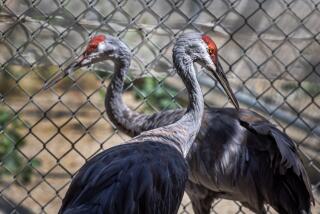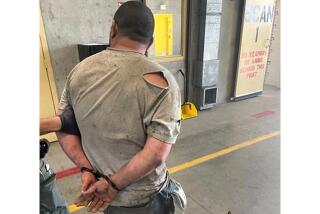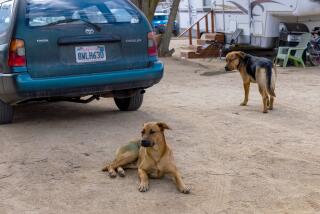Shooting of escaped Hearst Ranch zebras prompts outcry
- Share via
Along with hairpin curves and heart-stopping views of the Pacific, motorists on Highway 1 near San Simeon may glimpse a most exotic sight: a herd of zebras grazing in pastures along the road.
They are what is left of what was once the world’s largest private zoo — a menagerie of camels, kangaroos, emus and giraffes that roamed the estate of newspaper magnate William Randolph Hearst.
Last week three zebras — a buck, a mare and a yearling — escaped from Hearst Ranch and wandered over to nearby Cambria.
On Jan. 5, when two of the three turned up on David Fiscalini’s cattle ranch, he raised his shotgun and killed them. A neighboring rancher shot the third zebra.
Fiscalini told the San Luis Obispo Tribune that the two zebras that got onto his property had spooked his horses.
The incident has pitted local preservationists against those who say ranchers have the right to defend their livestock. It made the front page of the local newspaper Wednesday.
Fanning the controversy were reports of Fiscalini’s actions the day after the shooting, when he called a local taxidermist out to the ranch and said he needed one of the zebras skinned and its hide tanned. “He wants to make a rug,” said Rosemary Anderson, the taxidermist’s wife. “You can’t believe the controversy.”
When Anderson’s husband, Don, got to the ranch, Fiscalini told him about the third zebra, and said the neighbor that shot that one wanted a rug too, Rosemary Anderson said. She called Fiscalini’s actions “a wanton waste” but said, “This rancher felt that he was taking care of his property and getting rid of a predator.”
Eleanor Seavey, who owns Her Castle, a Cambria bed and breakfast, said she and her friends were disturbed by news of the killings: “They’re such beautiful animals — why would anyone kill them?”
They are also, she said, loved by visitors.
“Whenever the zebras are out, tourists stop to take their pictures,” she said. “It just delights them.”
Each year about 1 million people visit Hearst Castle, which has been maintained as a state historic park since the family donated it to the state several years after Hearst died in 1951.
The Hearst Corp. still owns the 128-square-mile ranch that surrounds the castle. It was once home to more than 300 animals but most were sold off in the 1930s, said William Randolph Hearst’s great-grandson, Stephen Hearst. But some sheep, deer and 65 zebras continue to graze there, he said.
The zebras, Hearst said, rarely venture beyond the fence, “but from time to time they do, and neighbors give us a call and we retrieve them.”
He said he was shocked that Fiscalini hadn’t called him instead of shooting them.
“Was the threat so imminent that his first thought was to make a rug out of them?” Hearst asked. “It’s just a shame, and it’s a little bit rude in my book. You know, neighbors are supposed to help other neighbors.”
Fiscalini, who was out branding Wednesday and could not be reached for comment, told the San Luis Obispo Tribune that he had no choice. “They are wild animals,” he said. “How are you going to catch them?”
More to Read
Sign up for Essential California
The most important California stories and recommendations in your inbox every morning.
You may occasionally receive promotional content from the Los Angeles Times.











